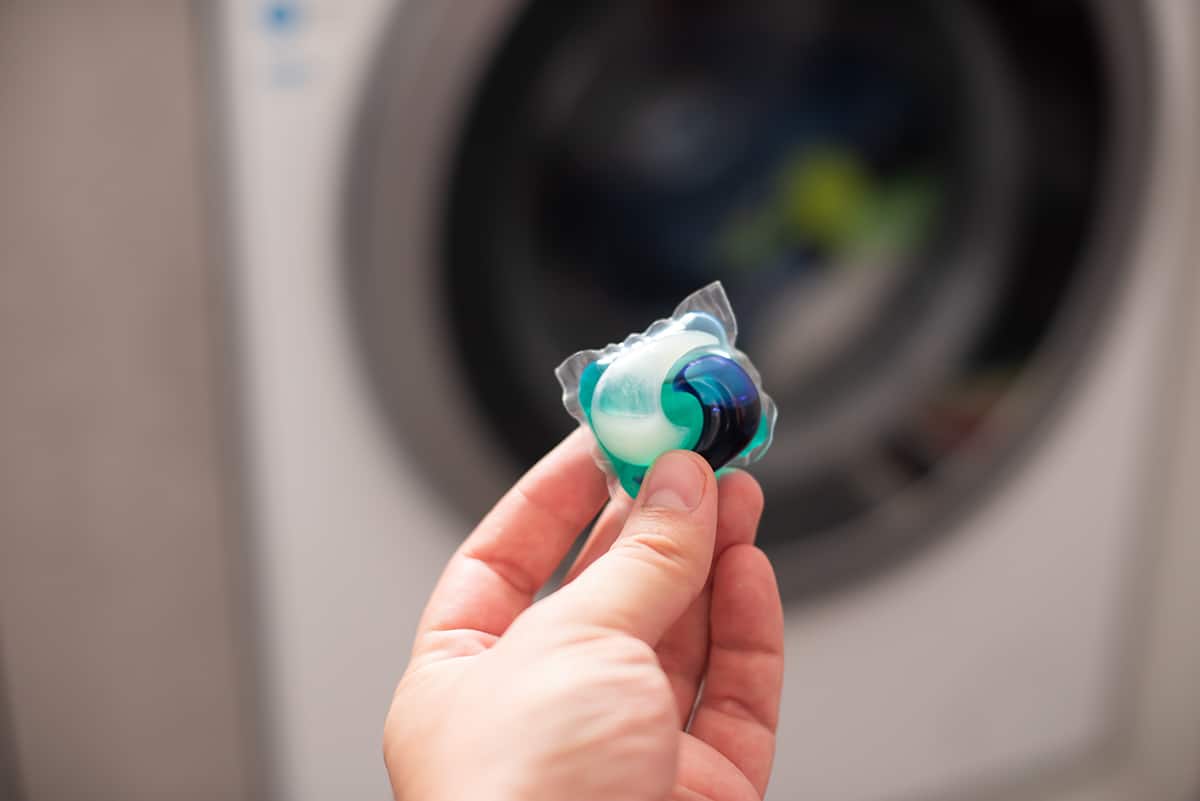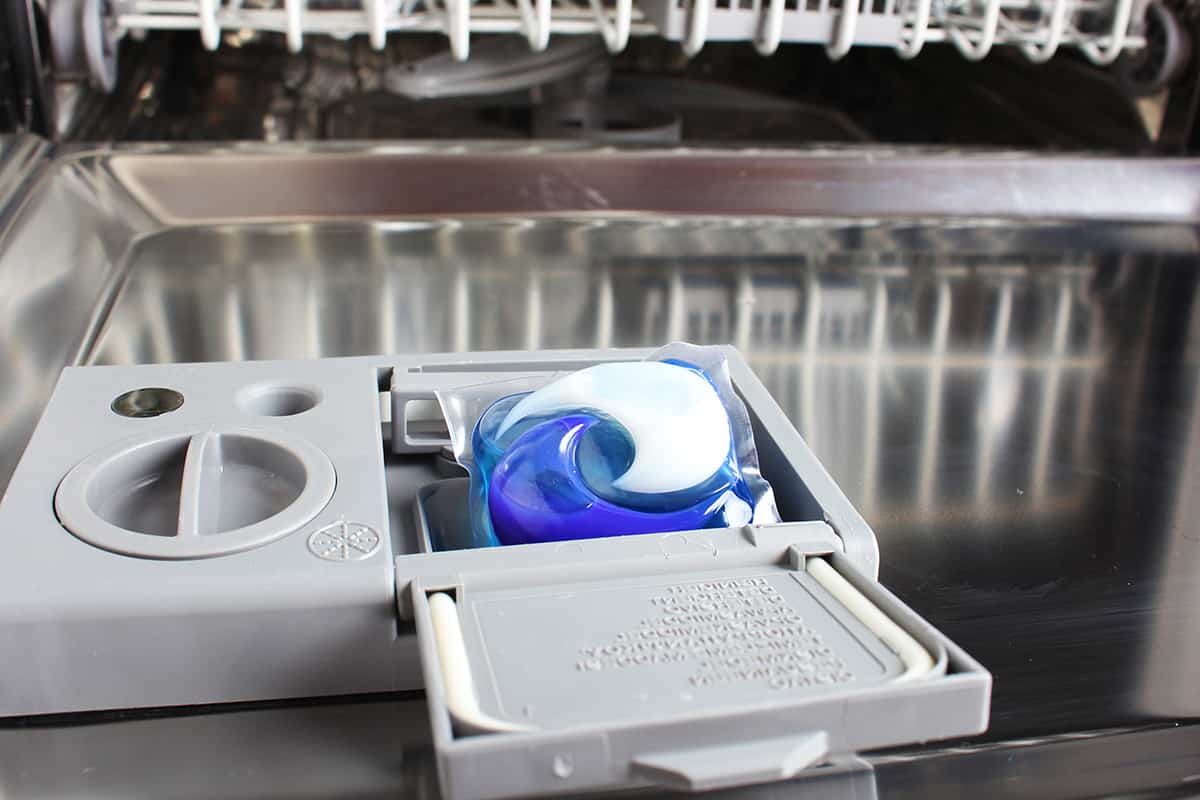Are you frustrated with dishwasher pods that just won’t dissolve? Not only is this an annoyance, but it can also lead to dishes that aren’t properly cleaned. But why is this happening?
These are the likeliest causes of why your dishwasher pods aren’t dissolving in the tub:
- Low water temperature
- Old pods
- Clogged sprayer arm
- Malfunctioning detergent dispenser
Knowing the cause is only half the battle. In this guide, I’ll describe what these issues are in more detail and what can lead to them, as well as discuss how to resolve them.
What Is a Dishwasher Pod?

A dishwasher pod is a small, pre-measured packet of detergent that you can use in your dishwasher to clean your dishes. It’s a convenient alternative to measuring out liquid or powder detergent, as you can simply pop one pod into the dishwasher’s detergent dispenser and let it do its thing.
Dishwasher pods usually contain a combination of cleaning agents and enzymes that work together to break down food particles and stains on your dishes. They come in a variety of scents and formulas, so you can choose one that works best for your needs.
How to Use Dishwasher Pods
Using dishwasher pods is a lot easier than scooping and measuring powder detergent. Here’s a quick breakdown of how to use these babies:
Locate the detergent dispenser. Modern dishwasher models will have a built-in compartment that receives pods.
- Place the dishwasher pod into the provided compartment.
- Close the detergent dispenser until you hear a click or until you’re sure the lid is shut tight.
- Start your dishwasher as you normally would.
During the correct cycle, the detergent dispenser’s lid will dispense the pod, allowing it to fall to the bottom of the tub. It will then get mixed with heated water that dissolves the casing and allows the detergent and additives to clean your dishes.
Dishwasher pods not dissolving – Causes & Fixes
If you’ve ever experienced the frustration of dishwasher pods not dissolving properly, you’re not alone! Let’s go over the various causes of why your dishwasher pods aren’t dissolving correctly and what you can do to correct the problem.
1. Low water temperature
Dishwasher pods are designed to dissolve in hot water, which activates the cleaning agents and enzymes inside. If your dishwasher’s water temperature is too low, the pod may not fully dissolve and leave behind a soapy residue on your dishes.
Solution #1: Run hot water from your kitchen faucet for 30 seconds before starting your dishwasher
Your hot-water pipes may be filled with lukewarm or cold water at the start of the day. Before running a wash cycle, turn on the hot water faucet in your kitchen sink and allow it to run for 30 to 60 seconds. This will force your water heater to fill the pipes with fresh hot water.
Solution #2: Increase the temperature of your water heater
Doing this can decrease how much time it takes your dishwasher’s heating element to raise the temperature of the water. However, this will also increase the temperature of hot water running throughout your entire home. So, only do this as a last resort.
Solution #3: Check the dishwasher’s heating element
You don’t have to supply your dishwasher with preheated water since the appliance’s heating coils will heat the water. That said, if the heating coils don’t work properly, then the water won’t get hot enough to dissolve the dishwasher pod or thoroughly rinse your dishes. You may need to replace broken parts if this is the case.
2. Old pods

The good news is that dishwasher pods have a pretty long shelf life of around 12 months. With 52 pods per box (at least in Cascade’s case), you should have enough pods for, well, 52 cycles before running out!
However, if you have spare pods from over a year ago, or if you stored them improperly, then you may have a pile of old, messy, and unusable dishwasher pods. There’s no telling what can happen to them as they age, but not dissolving may be one sign.
Solution: Replace the dishwasher pods
There’s no way around it—you’ll need to pick up a box of fresh dishwasher pods. Also, what you can do is stick to using your dishwasher 5 times per week. This doesn’t just keep your dishwasher in better condition, but it will also help you use up dishwasher pods more frequently, so you won’t have any left to spare after 12 months.
3. Clogged sprayer arm
The sprayer arm is responsible for spraying water onto your dishes during the wash cycle, which helps distribute the detergent and clean your dishes thoroughly. Sprayer arms can become clogged over time with food particles, mineral buildup, and other debris.
If the sprayer arm is clogged, water won’t be able to flow through it properly, which can prevent the dishwasher pod from dissolving completely.
Solution: Clean the sprayer arm
You’ll typically know when your dishwasher’s sprayer arm(s) aren’t working properly when they don’t spin and clean every part of your dishes. What you’ll need to do is clean the sprayer arms.
To do this, detach the sprayer arm from your dishwasher following the manufacturer’s recommendations.
Now, take a toothpick and carefully poke all of the clogs in the arm’s holes. Do this until the holes are perfectly clean. Lastly, rinse the arm in a basin of cold water before reinstalling it in your dishwasher and testing it out.
4. Malfunctioning detergent dispenser
Your dishwasher knows when to release the detergent dispenser’s lid. However, if the lid is stuck for whatever reason, then your dishwasher pod will remain in a sad state inside the pod compartment until you fish it out manually.
The detergent dispenser door can become stuck in place due to a buildup of old detergent debris or even loading your dishwasher improperly—e.g., a bowl is leaning against the door and preventing it from opening.
Solution #1: Load your dishes properly
Did you know you can overload your dishwasher? If you didn’t, then you should read the manual to see how to load your dishwasher properly and prevent detergent and rinsing issues from occurring.
Solution #2: Check the dishwasher detergent dispenser
I have a guide that explains in detail what you should do if the soap dispenser doesn’t work. Here’s a quick rundown of what you need to do in such an event:
- Check for a worn-out door seal
- Check for a damaged dispenser latch
- Make sure the soap dispenser lid is aligned correctly
- Scrub away any detergent buildup
- Inspect the wax motor
Replace the dishwasher detergent dispenser (extreme cases)
FAQs
1. Are dishwasher pods better than liquid/powder detergent?
Some people find that dishwasher pods are more convenient, while others prefer the flexibility of liquid or powder detergent. Ultimately, it’s up to you to decide which type of detergent works best for your household
2. Can dishwasher pods be used in any dishwasher?
In general, dishwasher pods are designed to be used in any dishwasher. However, it’s always a good idea to check the manufacturer’s recommendations for your specific dishwasher model to ensure that dishwasher pods are safe and effective to use.
3. Can I use more than 1 dishwasher pod at a time?
Yes, you can, but it’s not recommended. A single pod provides enough detergent, rinse aid, and other additives to clean an entire load. Adding a second pod could lead to a detergent overdose, leading to rinsing problems. That said, if you want to experiment, go right ahead, but don’t say I didn’t warn you!






